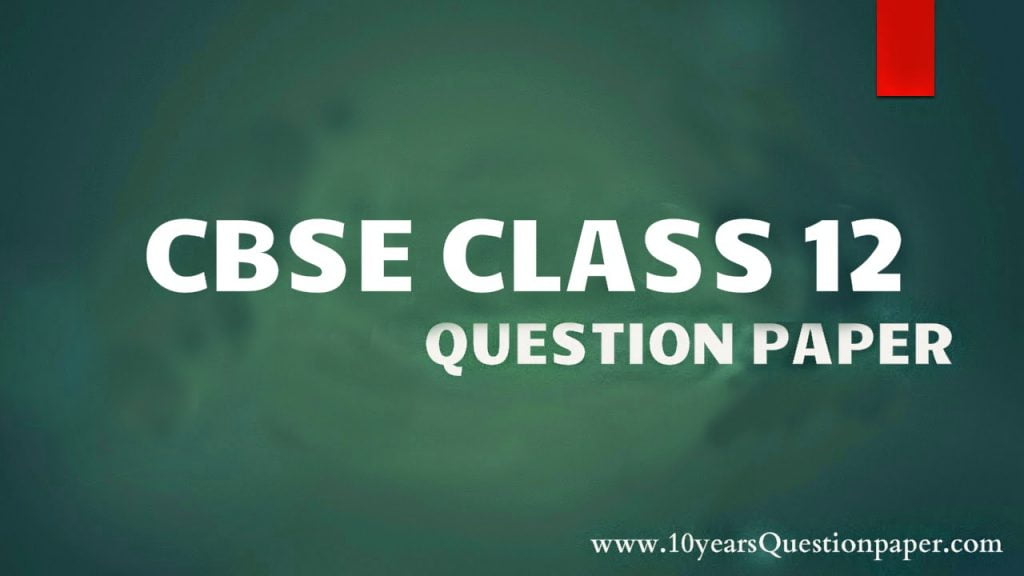
CBSE Practice Papers and CBSE Sample Papers for Class 12 Physics are very important and useful source for the preparation of CBSE board examinations.
With this article students can download the practice paper for CBSE Class 12 physics.
CBSE Class 12 Syllabus 2016 – 2017
About this CBSE Practice Paper for Class 12 Physics:
If we analyse previous year question papers of CBSE Class 12 Physics then we will notice that there are some very important concepts, questions based on these concepts are frequently asked in CBSE Class 12 Physics board examinations.
This solved practice paper for Class 12 physics is based on such frequently asked questions.
The pattern of this practice paper is same as that CBSE Class 12 Physics Board examination 2016. This paper is based on the latest CBSE Syllabus for Class 12 Physics 2017.
All the questions of this practice paper are important for CBSE Class 12 Physics board examination 2017.
CBSE Class 12 Mathematics 2017 Sample Paper
Latest format of CBSE Class Physics Board Examination 2017 board examination:
According to the latest pattern, in CBSE Class 12 Physics question paper:
| All questions are compulsory |
| There are 26 questions in all |
| Question number 1 to 5 carry one mark each |
| Question number 6 to 10 carry two marks each |
| Question number 11 to 22 carry three marks each |
| Question number 23 carry four marks |
| Question number 24 to 26 carry 5 marks each |
| There is no overall choice. However, internal choices have been provided in some questions |
| Use of calculator is not permitted |
Importance of this CBSE Practice Paper for Class 12 Physics:
With the help of this CBSE Practice Paper for Class 12 Physics 2017 board examination student will:
| Understand the latest CBSE Class 12 Physics board examination 2017 |
| Know about the important concepts of CBSE Class 12 Physics which are frequently repeated in CBSE board examinations |
| Learn time management by practicing the questions |
Some of the sample question from CBSE Practice Paper for Class 12 Physics:
Q. Name the part of the electromagnetic spectrum of wavelength 10– 2 m and mention its one application.
Q. What is the difference between kilowatt (kW) and kilowatt hour (kWh)?
Q. Name the absorbing material used to control the reaction rate of neutrons in a nuclear reactor.
Q. Where on the surface of the earth is the angle of dip 900.
Q. What is the focal length and power of a plane glass plate?
Q. A parallel plate capacitor with air between the plates has a capacitance of 8pF. What will be the capacitance if the distance between the plates is reduced by half and the space between them is filled with a substance of dielectric constant 6?
Q. The capacity of a capacitor becomes 20 μF when air between the plates is replaced by a dielectric slab of K = 2. What is the capacity of the condenser with air between the plates?
Q. Current flowing through a wire varies with time t in second is given by: I = (2t + 3) ampere. How much charge passes through a cross-section of the wire in 25 seconds?
Q. Define the term wave front. State Huygens’s principle. Consider a plane wave front incident on a thin convex lens. Draw a proper diagram to show how the incident wave front traverses through the lens and after refraction focuses on the focal point of the lens, giving the shape of the emergent wave front.
Q. Explain the following, giving reasons:
(i) When monochromatic light is incident on a surface separating two media, the reflected and refracted light both have the same frequency as the incident frequency.
(ii) When light travels from a rarer to a denser medium, the speed decreases.
Does this decrease in speed imply a reduction in the energy carried by the wave?
(iii) In the wave picture of light, intensity of light is determined by the square of the amplitude of the wave. What determines the intensity in the photon picture of light?
Q. A convex lens made up of glass of refractive index 1.5 is dipped, in turn, in (i) a medium of refractive index 1.65, (ii) a medium of refractive index 1.33.
(a) Will it behave as a converging or a diverging lens in the two cases?
(b) How will its focal length change in the two media?
Q. Using Rutherford model of the atom, derive the expression for the total energy of the electron in hydrogen atom. What is the significance of total negative energy possessed by the electron?
Q. Considering the case of a parallel plate capacitor being charged, show how one is required to generalize Ampere’s circuital law to include the term due to displacement current.
Q. Hary is a student of class X in a village school. His uncle gifted him a bicycle with a dynamo fitted in it. He was very excited to get it. While cycling during night, he could light the bulb and see the objects on the road. He, however, did not know how this device works. He asked this question to his teacher. The teacher considered it an opportunity to explain the working to the whole class.
Answer the following questions:
(a) State the principle and working of a dynamo.
(b) Write two values each displayed by Ram and his school teacher.
Q. (a) Deduce an expression for the frequency of revolution of a charged particle in a magnetic field and show that it is independent of velocity or energy of the particle.
(b) Draw a schematic sketch of a cyclotron. Explain, giving the essential details of its construction, how it is used to accelerate the charged particles.





